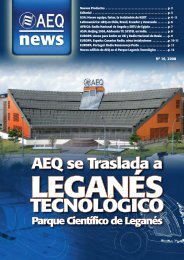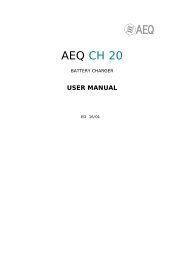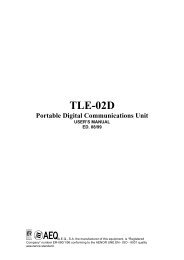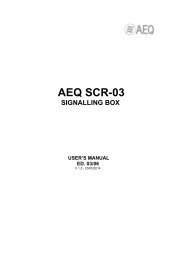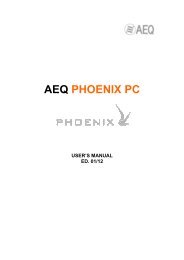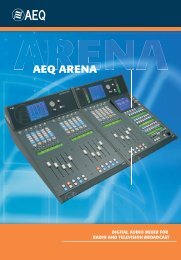Manual - AEQ International
Manual - AEQ International
Manual - AEQ International
Create successful ePaper yourself
Turn your PDF publications into a flip-book with our unique Google optimized e-Paper software.
For complete information on RTP/RTCP protocol, <strong>AEQ</strong> recommends consulting:http://tools.ietf.org/html/rfc1889http://tools.ietf.org/html/rfc1890http://tools.ietf.org/html/rfc3550http://tools.ietf.org/html/rfc3551http://tools.ietf.org/html/rfc3711C3.1. PHOENIX MOBILE default configuration.PHOENIX MOBILE is an IP audio coder that operates by using RTP over UDP in IP version 4.By default, PHOENIX MOBILE is supplied from the factory with the following IP ports defined:5004 for RTP and 5005 for RTCP if this protocol is used.C4. SIP Protocol.Session Initiation Protocol (SIP) is a protocol developed by the IETF MMUSIC Working Groupwith the intention of establishing the standard for initiating, modifying and ending interactiveuser sessions where multimedia elements such as video, voice and instant messaging areinvolved.SIP is used simply to initiate and terminate voice and video calls. Once the communication isestablished, the exchange of voice / video information is conducted only over RTP.One of the objectives of SIP was to contribute a set of processing functions to apply to calls andcapacities present in the public switched telephone network. Thus, it implemented typicalfunctions that a common telephone terminal offers, such as: calling a number, making atelephone ring when called, hearing a dial tone or busy tone. The implementation andterminology in SIP are different.SIP requires proxy servers and register elements to give a practical service. Although two SIPterminals can communicate with each other without the mediation of SIP infrastructures throughthe use of URIs of the name@IP-address type (which is why SIP is defined as a point-to-pointprotocol), this approach is impracticable for a public service because of the problems inherent inIP addressing, where obtaining static public addresses is nearly impossible and extremelycostly.To simplify the operation of the unit, <strong>AEQ</strong> offers without aftercost for Phoenix Mobileusers the services of proprietary SIP server, though 100 % of the time can neither guaranteefunctioning nor make responsible for the disadvantages that could suppose therefore the finaluser. The unit goes out of factory preconfigured with the necessary parameters to work usingthe resources of this SIP server (see "Default SIP configuration for PHOENIX MOBILE" in thismanual).SIP makes use of elements called proxy servers to help route the requests toward the user’scurrent location, authenticate users to give them service, enable call routing policies to beimplemented, and contribute added capabilities to the user.SIP also contributes register functions that enable the user to inform the proxy servers of his orher location.For complete information on the SIP protocol, <strong>AEQ</strong> recommends consulting:http://tools.ietf.org/html/rfc3261<strong>AEQ</strong> PHOENIX MOBILE91





